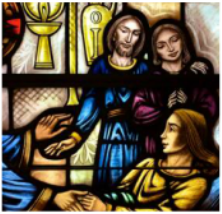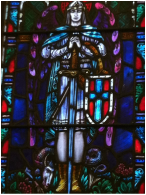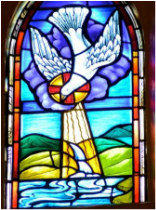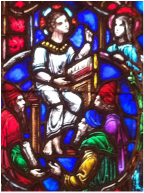Our Stained Glass Windows

Stained glass windows, originally used by wealthy Romans in their homes, were used in Christian churches as early as the fourth century.
Window designs showed Biblical characters, saints, martyrs, and God. They were intended to do more than simply add light and beauty to the church. With the stories they told, they could educate worshipers on the history and traditions of their faith.
Stained glass windows came to have great spiritual significance, just as they do for us today.
Trinity is famous for the beauty of its stained glass windows, said to be among the best examples of contemporary stained glass windows in this area.
The windows, installed over many years, vary in design and construction.
Tiffany Windows Considered to Be Collectors Items
Some of the earliest windows were created by Louis C. Tiffany of New York, who felt that stained glass windows ought to look like paintings. His windows were made from multiple layers of glass to add dramatic dimension and color. The windows are in their full glory when they’re illuminated by sunlight.
Trinity’s Tiffany windows are considered collectors’ items.
Other windows in the church were created by Willet Studios of Philadelphia, Westminster Memorial Studios, and others. The windows in the east and west transepts, the War Memorial window, and the Rardin windows were created using slab glass from the Blenko Glass Co. of Milton, West Virginia. Trinity also has one mosaic in the cloister. It has no back-lighting, but is still quite lovely to look at.
When you visit Trinity, see if you can notice the differences between the Tiffany windows and those created by other studios!
(Photography by Jay Swann Photography)

THE VESTIBULE
The Hite Window, The Lord Giveth. Given in Memory of Stephen Ensign Hite.
This window is at the very back of the church, set high above the nave. The window depicts the angel of life on the left, the angel of death on the right, and above both, at the top, is the resurrection.
It’s a beautiful and touching memorial to Stephen Ensign Hite, who died as a teenager after being kicked by a horse. Stephen was a descendant of Mr. Ely Ensign, who was one of Trinity’s founders as well as founder of what became known as American Car and Foundry.
The window was given by Stephen’s parents, Mr. and Mrs. F. Ely Hite. Inscribed on the window is a quotation, almost verbatim, from
Job 1:20-21 KJV: “The Lord giveth, the Lord taketh away,
blessed be the name of the Lord.”

THE APSE
The Haddad Window,
The Holy Spirit (The Dove).
Given in memory of
Edward Michael Haddad.
This window, The Holy Spirit (The Dove), is in the Apse, the area just behind the altar. The window was made in Huntington by
Dennis Shobe.
The dove is a symbol of purity and harmlessness, and signifies the spirit with which Jesus was endowed. The dove is mentioned in Luke as being at Jesus’ baptism in the river Jordan, and a dove also has a role in the story of Noah’s Ark: Released by Noah to find land, the dove came back with an olive branch, which forever after has served as a lasting symbol of peace.
While this window is at the top of the apse (the vaulted arch over the chancel stairs), there is a plaque on the back wall of the nave with details about the window: The clerestory “Holy Spirit” window over the apse Given to the Glory of God and in memory of Edward Michael Haddad by his wife Dr. Mary Louise Tweel Haddad and his daughter Kathryn Ann Haddad Goodman, 1989.

THE NAVE
The Hamilton Windows
The Prodigal Son. Given in Memory of Ruth Hamilton Wandel (1924-1962).
The Good Samaritan. Given in Memory of James Love Hamilton, Jr. (1928-1959)
These two beautiful windows in the Nave were given by Mr. and Mrs. James Love Hamilton. The Prodigal Son is in memory of their daughter, Ruth Hamilton Wandel. As you face the windows, the left represents the story of the Prodigal Son (Luke 15:11-32), in which the younger son has asked for his inheritance, then squanders it in wild living.
Realizing his foolishness, he returns to his father, asks forgiveness, and is received by his father with open arms and compassion. The upper part of the window shows the older son working cutting wheat in the fields, as he thinks a good son should, and preparations for celebrating the “lost” son’s return with a fatted calf and fine garments.
The Good Samaritan is in memory of the Hamiltons’ son, James Love Hamilton, Jr. On the right you can see the Good Samaritan (Luke 10:25-37) who helps a wounded traveler, while in the upper part of the window are depictions of a priest and the Levite who passed the traveler by. When a lawyer asks, “What must be done to inherit eternal life,” Jesus recounts the parable of the Good Samaritan. Then, to complete the teaching, Jesus tells us, “Go and do likewise.”
